Los Angeles, USA, January 10th - 20th, 1910
The first aviation meeting in the USA

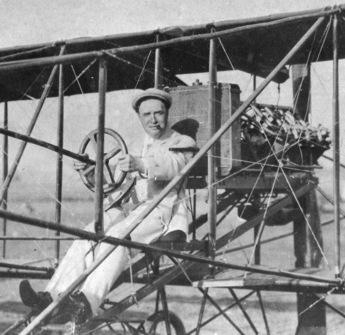

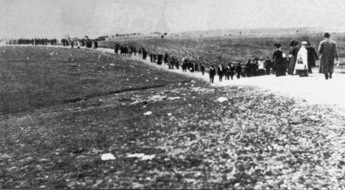

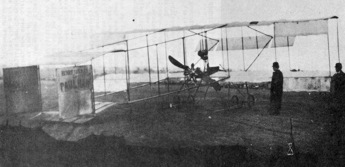
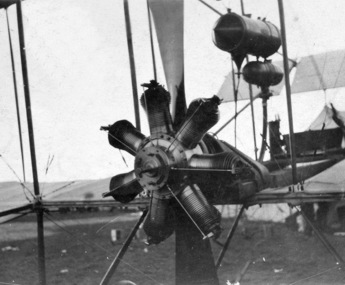

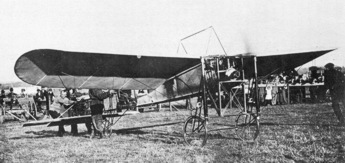
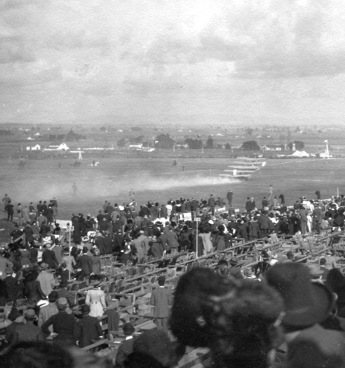
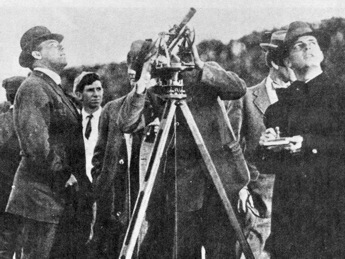
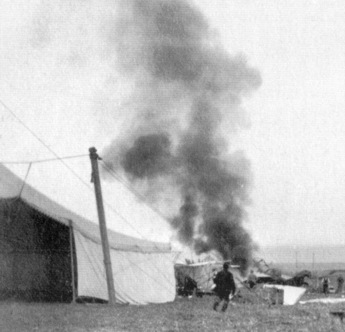
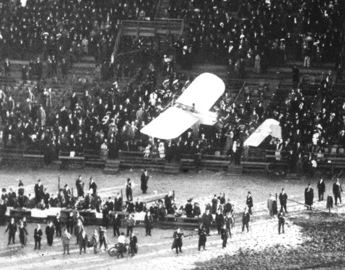
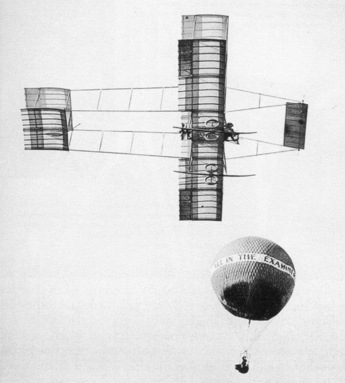
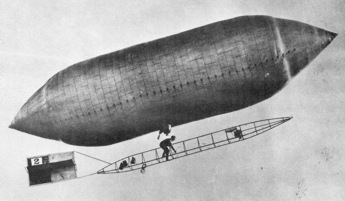
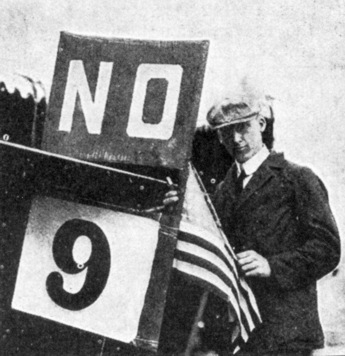
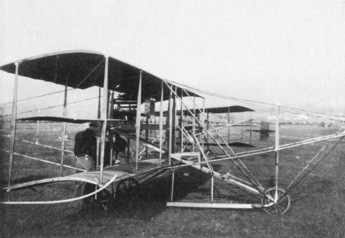
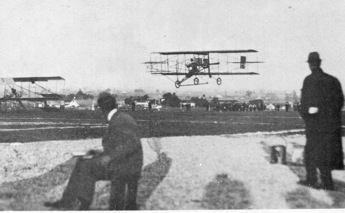
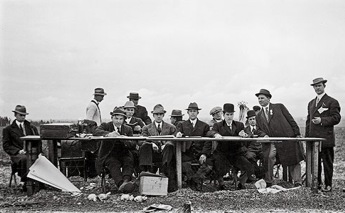
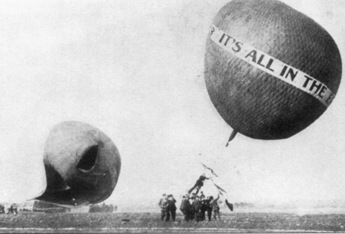

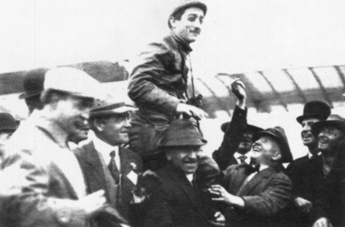
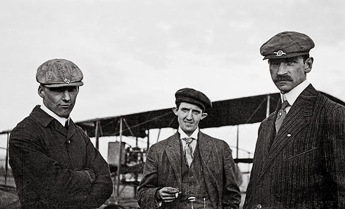

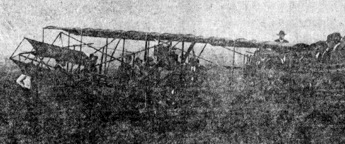

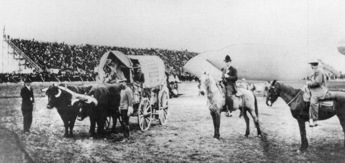
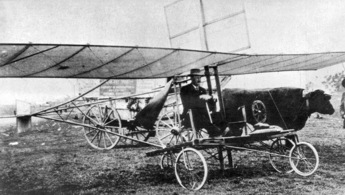

Aviation meetings, and aviation industry in general,
were slow to take off in the United States. One of the
reasons was that the Wright brothers had been granted a
patent which gave them exclusive rights to some aspects
of airplane control, particularly roll control by wing
warping. They threatened litigation against anybody who
built or displayed airplanes.
This did not stop people from trying. A couple of minor
displays were held during 1909, and in connection with
one of them, the 12-14 November Cincinnati meeting
(actually held in nearby Latonia, Kentucky), Glenn
Curtiss' partner Charles Willard met Roy Knabenshue,
who made exhibition flights in his little airship. They
agreed to try to organize something in Los Angeles during
the winter, and got support from Curtiss. In 1910 Los
Angeles had a population of more than 300,000. After
having been a mere village during the mid-1800s the
population had grown enormously, driven by improved
communications and a huge increase in trade, mainly in
fruit but also in petroleum and industrial products. The
population had tripled during the last three years.
Willard and Knabenshue contacted Dick Ferris, a Los
Angeles businessman and balloon enthusiast who had
participated in organizing similar events before. He put
the idea forward to the Los Angeles Merchants and
Manufacturers Association, who promised to raise the
necessary funds, for example a prize fund of 80,000
dollars. Curtiss and Willard visited possible sites and
settled for the Dominguez Hill, close to Compton some 20
kilometres south of Los Angeles. This site had several
advantages: It was close to the railway, it was free from
obstructions and it was situated on a low mesa, so that
anybody who wanted to see the action would have to pay
the entrance fee. Furthermore, the owners of the site,
the Dominguez family, let them use it for free. An
engineer, S. B. Reeve, was hired to prepare the site,
construct the grandstand and build pylons to mark the
course. A committee consisting of Dick Ferris, US Aero
Club president Cortlandt F. Bishop, Edwin Cleary and
Jerome S. Fancuilli, took care of the program and
rules.
An early list of entrants contained 43 airplanes and six
airships, but in the final program the number was down to
eleven and three respectively. The Curtiss team would
bring four planes, to be flown by Glenn Curtiss, Charles
Willard, Charles Hamilton and Clifford Harmon. The latter
in fact took delivery of his brand new plane at the
meeting and was to receive flight training there. The
Wright brothers did not participate and there weren't
many other American aviators around, although several
optimists would bring their untested constructions to the
meeting.
In order to get a more international status Louis Paulhan
was invited. He accepted, no doubt attracted by the
generous offer of a reported 150,000 francs for a
three-month tour, and started to build up a team. In
addition to his two Farman planes he bought two Blériot
XIs and spent three days in the beginning of December at
the Blériot flying school in Pau in southern France
learning to fly them. Paulhan would travel in company
with his wife, their black poodle, his business partner,
a marquise (or baron, depending on your sources) with the
fantastic Breton-sounding name of Robert de Kersauson de
Pennendreff, and his wife. The team included two
mechanics, Didier Masson and Charles Miscarol, who were
also entered as pilots but had actually flown very little
before leaving France.
Three airships were entered, the two small "racing
dirigibles" of Knabenshue and Lincoln Beachey and a
US government ship, which in the end never appeared since
it could not be filled at the airfield. There were also
competitions for balloons, which were not held at the
airfield, but at Huntington Park, some 10 kilometres to
the north. Seven balloons were entered and made regular
flights during the meeting, but the new-fangled, exciting
airplanes got most of the attention from the press and
the public.
When Paulhan arrived in New York he was immediately
served with an injunction from the Wright brothers, who
wanted to forbid all his flights in the USA because the
control systems infringed their patents. He received a
second injunction in Denver, Colorado, on the way to Los
Angeles. The suit was due to be heard in court, but the
hearing was adjourned to January 28th, so in the interim
Paulhan could participate in the meeting. The Wrights
demanded all the profits from Paulhan's flights plus
three-fold damages, since they claimed Paulhan's
flights would destroy the novelty of flying machines.
This was stated to be a big loss to the Wrights, since
public desire to see machines in flight would be
satisfied before it would be possible for the Wrights to
display their planes.
Monday 10 January, "Aviation Day"
The weather was perfect on the first day of the meeting,
sunshine and only a light breeze. A crowd of around
20,000 people waited patiently for the first flight in
the West. Curtiss had made a couple of short test hops in
Harmon's brand new plane the day before, but they
could hardly count. At one o'clock Curtiss finally
rolled out Harmon's plane and made a flight of one
and a half minute, covering around one kilometre. Willard
was the second to fly soon afterwards, flying a mile in
1:23. Paulhan decided to show off a little and taxied
away from the grandstands out of his tent hangar, which
faced away from the grandstands and was hidden from view
by the Curtiss hangar. He then took off out of sight
while the crowd was looking at the dirigibles of
Knabenshue and Lincoln Beachey and suddenly appeared at
full speed in front of the crowds. Paulhan, showing
"brilliant daring", was the only flyer to
complete a whole lap of the course during the first day,
making three flights of totally around 30 kilometres.
During one of them he easily overtook Knabenshue's
airship, travelling around twice as fast. Curtiss made a
second short flight in his V8-powered "Rheims
Flyer", breaking his propeller when landing in an
uneven spot. Hamilton also made a flight of 1.5 miles in
his four-cylinder Curtiss. The engine of the Gill-Dosh
machine, to be flown by Hillery Beachey, brother of
Lincoln, "exploded" in the hangar and damaged
the top wing. Several flyers complained of the fuel
provided, which was claimed to be "muddy" and
cause the engines to overheat. Better fuel was promised
for the remainder of the meeting.
Tuesday 11 January, "Los Angeles
Day"
Heavy rain during the night before made the roads muddy
and caused many cars to get stuck in the access roads. A
large work force was sent out to improve the roads with
straw and planks. The second day of the meeting started
windy, with gusts of up to 20 m/s. Towards the afternoon
Paulhan made three flights, the longest of some 15
kilometres, and he also made a passenger flight.
Otherwise the afternoon was spent on take-off and
precision-landing contests. At the Los Angeles meeting
the participants were free to try for the different
events whenever they wanted, and since these contests
didn't require a lot of flying they were preferred on
a windy day. Curtiss took the lead in the shortest
take-off contest by starting in 29.9 m, while Paulhan in
his Farman needed 56.2 m. Curtiss also made the quickest
take-off. His time was 6.4 s from the first explosion of
the engine to leaving the ground, while Paulhan could
only manage 12.4 s with the Farman and 35.0 s in one of
the Blériots. Curtiss' results were both claimed to
be world records. In the precision-landing contest
Willard was the only one to make a perfect landing inside
the 20 foot square target.
Paulhan's Blériots were flown with their wing-warping
mechanisms disconnected. This was in order to respect the
Wright patent, which didn't clearly cover ailerons,
but definitely covered wing-warping. This of course
limited their performance and made them difficult to
control. Paulhan's inexperienced trainee Miscarol
tried to make a flight, but after a slow flight of around
1.2 km he was caught by a gust and broke a wheel in the
resulting rough landing. Paulhan, perhaps eager to show
that it was possible, took out the other Blériot for a
flight of some 3 km.
The wind decreased during the afternoon, allowing Curtiss
to take his business manager Jerome Fanciulli for a
flight of around 1.6 km. During the flight he was
measured to make 55 mph (88.5 km/h), which was faster
than the world speed record. In a couple of European
magazines this was misunderstood and it was claimed that
he had set a fantastic new record by making a one-hour
passenger flight of 55 miles.
There were more accidents and incidents. Hamilton got too
low during a short test flight and hit the ground,
breaking his elevator. Professor Zerbe tried to make a
flight in his five-wing plane, but just when he reached
take-off speed a drive chain broke. The plane fell to one
side, breaking a wheel, a propeller and the lower wing
tips. The professor thankfully escaped injury. A much
more dangerous incident happened in one of the hangar
tents. Edgar Smith was doing an engine test on his
tandem-wing monoplane and accidentally got into to the
turning propeller. He was thrown more than ten feet by
the impact and the metal propeller was folded double. He
must be considered lucky to have got away with a
five-inch cut on the back of his head and badly bruised
arms. After being transported to his home in
"delirious and hysterical" condition he was
back later during the week, with his head in a
bandage.
Wednesday 12 January, "San Diego
Day"
Five days earlier, on January 7th, Hubert Latham in his
Antoinette had raised the world altitude record to 1,050
m at Mourmelon in France. Paulhan was of course keen to
better this mark, and especially so in view of the bonus
prizes to be paid for world records. The third day of the
meeting was a very promising day, clear and with little
wind. During the afternoon Paulhan made his previously
announced effort for the altitude prize and the world
record. For 43 minutes he circled ever higher and after
the landing seven and a half minutes later the barometric
altimeter carried on the plane indicated an altitude of
4,600 feet (1,402 m). This figure was not approved by the
committee, since the altimeter was not considered
accurate because of the inconsistent atmospheric
conditions and its exposure to the vibrations of the
engine. The trigonometric calculations performed by
students of the Polytechnic High School indicated that
the altitude reached was 4,165 feet, equivalent to 1,269
m, and these figures were the finally approved.
There was also action around the pylons. Curtiss started
by flying a 2:13.6 lap with Harmon's machine. He then
continued by improving the time to 2:12.4, this time
flying Willard's "Golden Flyer".
Paulhan's Farmans could not match these times, his
best lap was 2:25.6. Paulhan also made a five-lap run,
but the time of 12:23.2 was unofficial, since there
weren't pylon judges at all pylons. Hamilton had
persistent engine trouble but finally managed to complete
a lap of the course and a short cross-country trip.
Harmon made his maiden flight in his new Curtiss, a short
hop around 30 meters.
Thursday 13 January, "Pasadena Day"
The Thursday was another clear day and the spectators got
to see a fair bit of flying. In the morning Hillery
Beachey took out the repaired Gill-Dosh for a test, but
broke one of the lower wings when he came to earth in
rough ground. Beachey was uninjured, but the machine
would require new repairs. Paulhan carried eight
passenger, among them his wife and Mrs. Ferris, wife of
the meeting organizer. He also carried both his
mechanics/trainees Miscarol and Masson during a flight.
Both Curtiss and Paulhan made efforts for the 10-lap
speed contest, Curtiss beating Paulhan by only five
seconds, 24:54.4 to 24:59.4. During Curtiss' flight
Paulhan cut in before him which made Curtiss' plane
drop dramatically in the wash.
In the hangars there was a dramatic incident when the
Klassen "Butterfly" monoplane caught fire. All
the fabric was burned off, and the fire threatened to
spread to the Paulhan camp before bystanders could put it
out. Willard made another perfect effort for the
precision take-off and landing contest by taking off and
landing in the same 20-foot square.
Friday 14 January, "Southern California
Day"
Another beautiful day and another spectacular flight by
Paulhan. He again took off out of view from the
grandstands and after buzzing them he left he airfield in
the direction of the coast. He flew to San Pedro and
circled the fortifications of Point Firmin and the
harbour, where he was greeted by ship steam whistles and
bells. The flight was estimated at some 33 km. After
landing Paulhan remarked that he could easily have
bombarded the fortifications. On the airfield several
pilots tried for a quick lap. Curtiss improved his best
time to 2:12.0. Paulhan made the lap in 2:21.2, while
Willard made two laps with a best of 3:01.4 in his
Curtiss, which had a four-cylinder engine of half the
power. Paulhan made a lap in 2:48.0 in one of his
Blériots. This was the only official lap made by a
monoplane during the entire meeting.
Curtiss carried Lieutenant Paul Beck of the US Army as a
passenger in order to try to bomb a target on the ground
with bags, but engine trouble caused them to abort and
postpone the test. Paulhan took Masson for an 18-minute
dual-instruction flight in the Farman, covering six laps
of the race course. He then took Courtland F. Bishop, the
president of the US Aero Club, for a flight. The flight
must have made some impression on the balloonist Bishop,
who lost his borrowed cap during the flight and held on
to the struts with such force that they reportedly had to
be pried off after the flight. Getting off, he then got
so entangled in the rigging of the plane that he needed
help to be released.
Roy Knabenshue posted a best lap time for dirigibles with
5:10.4, and won a race with Lincoln Beachey in 6:29.6
versus 7:50.0. Even though slow, with a top speed of only
30-35 km/h, the small dirigibles were popular with the
crowd, since the pilots had to climb acrobatically around
their "nacelles" in order to keep their ships
balanced. Towards the evening the spectators were treated
to the spectacle of seeing three biplanes, two dirigibles
and one balloon in the air at the same time. This was one
of the most successful days of the meeting. It was
estimated that a total of 50,000 spectators were present,
bringing 5,000,000 dollars worth of automobiles.
Saturday 15 January, "San Francisco
Day"
After the fine weather of the beginning of the meeting
the weather turned worse, with rain clouds drifting in
from the sea. After a miserable morning the weather
improved during the afternoon and Paulhan was first to
fly. He again took off out of sight before buzzing the
grandstands twice, the second time with an unlit cigar in
his mouth. Hamilton was next to fly. While he was
completing the third lap of a planned ten-lap run Paulhan
took off and tried to make a race with the much slower
Curtiss. He quickly reached him and dived down to pass
Hamilton from below. Hamilton was thrown far off course
by the wash and was for while heading towards the
grandstand before regaining control. He eventually
completed the ten laps in 30:34.6 with a best lap time of
2:57.6, but after a second similar event Paulhan was
getting unpopular with the other flyers for interfering
with their flights.
Knabenshue in his dirigible also tried to prove the
possibilities of aerial warfare by bombing the 20 foot
precision landing square in front of the press boxes. He
managed to maneuver above the square and throw his bags
of earth accurately, but at an altitude of 20-30 meters
he would have been an easy target, and the ship would
probably have been blow to bits if real explosives had
been used.
Curtiss, Paulhan and Willard made one-lap qualifying
flights with times of 2:19.4, 2:33.8 and 3:03.4
respectively. Hamilton also flew a lap, but the time
isn't known. Towards the end of the afternoon
Miscarol took out one of the Blériots for engine tests.
He was running back and forth on the ground at relatively
high speed along the back straight of the course when he
suddenly lost control of the plane after a turn. After a
couple of wild swerves the left wing hit the ground and
crumbled and the plane came to rest on its side with
broken landing gear and propeller. The accident happened
far from the grandstands and the hangars. Miscarol had
knocked his head during the crash and was found running
around dazed and confused. He fortunately escaped with a
bruised forehead. The accident was blames on the Wright
brothers, since the Blériots had to be flow with their
wing-warping mechanisms locked.
Sunday 16 January, "Special Day"
This day also started rainy and the rain didn't stop
until around two o'clock. Although improved, the
roads were still difficult and some auto parts dealers
were making good business selling anti-slip chains. It
was still windy, though, and when Hamilton tried to fly
for the endurance flight he was blown off course and had
to land. Curtiss, Paulhan and Willard all tried to fly,
but all gave up after a lap or two. Curtiss estimated the
wind to 10 m/s (more than 20 mph) and said that even
though he was holding back he travelled along the
grandstands at 100 km/h (more than 60 mph). Paulhan tried
for the short take-off prize and improved his result to
36 meters, but not enough to beat Curtiss. Hamilton set a
time of 9.2 s for the quick take-off prize, but again not
enough to beat Curtiss. Towards sunset the wind decreased
somewhat and Paulhan made a passenger flight. The two
dirigibles also flew, but pitched and rolled and could
make very little headway against the wind, so they were
soon retired to their hangars again.
Paulhan created a minor incident in the evening by not
appearing at a dinner held in his honour by 80 members of
the Cercle Coquelin, a French society of Los Angeles. He
was dining with his friends at another restaurant and his
manager had to be sent to apologize for his failure to
appear.
Monday 17 January, "Free Harbor Day"
The rain had stopped and the morning was clear and
bright. In the morning Curtiss made several flights, one
of them with Lieutenant Beck of the US Army as passenger,
a second with Frank Johnson, a trainee pilot. He also
made a speed run of one lap in 2:18.8. Paulhan made a
test flight. At 2:15 Paulhan took off, trying for the
endurance record. It was speculated that he had enough
fuel to fly for twelve hours. When Paulhan had flown for
50 minutes Hamilton decided to also go for the endurance
prize. Paulhan's Farman was slightly faster than
Hamilton's four-cylinder Curtiss and caught up with
him and overtook him. Hamilton's plane "rocked
and swayed and rolled like a channel boat in a heavy
sea" in the wash. Willard was watching
Hamilton's flight through binoculars and noticed that
a wing strut was hanging loose and a wing tip was
flapping, so the next time Hamilton passed he was flagged
down. After landing it was found that a bolt had worked
loose and the right rear wing strut had slipped from its
socket. He had been in the air for 39:00.4 and had
travelled 31.3 km. Paulhan also ran into trouble. A smell
of gasoline was felt every time he passed and a fuel leak
was suspected. He came down to land after 1 h 58:32.0 in
the air, having covered 121.9 km at an average speed of
61 km/h, and it was verified that there was a leak in a
fuel line. He then made a flight in his other Farman
before trying Willard's Curtiss. This was not a
success and the rough landing after a very short flight
broke some rigging wires and fittings.
Curtiss again tried for the 10-lap record, improving his
previous best with more than a minute to 23:43.6.
Paulhan's training flight with Masson in the Farman
three days before had apparently paid off, since Masson
managed a good solo flight around the course. Hillery
Beachey made two successful short starts in the Gill-Dosh
plane, but broke the landing gear on the last landing,
giving the mechanics further work to do.
Tuesday 18 January, "Ladies'
Day"
On the ninth day of the week temperatures dropped. Cool
wind from the north brought clear air, some small clouds
and single-figure temperatures in the morning. There
wasn't much activity in the hangars. At one
o'clock a Curtiss machine was rolled out, waiting for
the wind to allow a take-off, but nothing happened. One
of the balloons from the Huntingdon Park balloon field,
the "New York", carrying George Duesler, George
B. Harrison and Charles Willard, managed to fly up to the
airfield. They landed at the west end of the field and
the balloon was towed to the center of the field and
anchored there, ready for Clifford Harmon, who planned to
try to set an official balloon height record.
At around two o'clock the wind suddenly changed from
north to west and increased to gale force. This caused
frantic activity on the field. The Curtiss machine was
quickly rolled back into its tent. Many hands helped in
pulling down the "Examiner" balloon, which had
been tethered at the field during the entire week. E. J.
Spencer, a photographer from the Los Angeles Examiner was
in the basket and kept taking photographs while the wind
blew the balloon to the ground. The anchor rope held and
Spencer could get out after the balloon had been drawn
down to its anchor post. It was probably lucky that he
was there, since without his weight the balloon might
have broken its mooring line. The much bigger "New
York" was in a much more dangerous situation. Some
of the rigging broke while it strained on its lines and
the bag became loose in the net. Clifford Harmon finally
had to pull the rip cord to split the side of the bag and
release the gas. The loose fabric collapsed to the ground
but the $5,000 balloon was saved.
The wind was still estimated to around 13 m/s at three
o'clock when Paulhan rolled out his Farman and flew a
lap. Undeterred by the wind, which blew at around three
quarters of the top speed of his plane, he took off again
at 15:08 and after circling the field left it and headed
towards the north. The bulletin board announced
"Paulhan will fly to Baldwin's Ranch and return,
45 miles. Back in an hour". Many cars followed the
flight, and in one of them "Madame Paulhan mingled
prayers and shouts of joy, while tears coursed down her
face", according to a melodramatic newspaper report.
Information about his progress was telephoned in and was
progressively reported on the bulletin board. After 30
minutes he had reached Arcadia and circled the Santa
Anita race track, before turning back toward the
airfield, rising to around 640 metres. After a wide
circle through Huntington Park in the eastern part of Los
Angeles he could be spotted from the grandstands again.
The band played the Marseillaise as he landed after being
in the air for 1 h 02:42.8 and covered an estimated 76
kilometres. The crowd raised him to their shoulders, but
he asked to be let down so that he could retire to his
hangar. When the wind had calmed down in the afternoon
Curtiss tried twice to improve his record for short
take-off distance, but failed. Hamilton also tried, and
reached 47.2 m. This was the last flight of the day.
During the evening the Pasadena society organized a
charity ball in honour of the aviators. The Paulhans, the
Curtisses, the Ferrises, the de Pennendreffs and Clifford
Harmon were the centre of attention and were served at a
magnificent table of plate glass, illuminated from
beneath by cut glass chandeliers lit by electric bulbs.
The table service and flower decorations were part of the
aviation theme, with "a biplane worked in violets
and greenery and a dirigible and a monoplane in red
carnations and greenery".
Wednesday 19 January, "Arizona Day"
On the Tuesday morning the Los Angeles Herald had
published an article headed "Avation and
Booze", which reported how "occupants of the
grandstand at Aviation Park have been surprised and
shocked by the unblushing and vociferous assiduity with
which perambulating bartenders, carrying their stock of
bottles and glassware in baskets, have plied their
vocation In the midst of the gathering of respectable men
and women". This obviously had effect, because the
next day they reported on the first page that "the
promiscuous sale of liquor at Aviation Park has ceased
suddenly". Chief Detective S. L. Browne of the
district attorney's office stated that "The
liquor selling in the grandstand was stopped before I
reached the grounds. But I found three bars running in
the tent at the rear, and everything there was booming. I
closed the bars, and closed them tight".
Flying conditions were perfect for most of the day, with
clear air and almost no wind. Paulhan took his wife for a
ride out westwards to Redondo Beach and Hermosa Beach at
the coast and back. The flight took 33:45.4 and was
estimated at 34.2 kilometres, a world record distance for
a cross-country passenger flight. Later during the day he
took six other passengers for rides, including newspaper
tycoon William Randolph Hearst. During one of the flights
the passenger was Lieutenant Paul Beck of the US Army and
the purpose was to drop dummy bombs on a 25-foot square
target marked on the ground. The attacks were made from
an altitude of 75 metres and were not quite successful,
because the bombs had to be dropped by the pilot. The
best bomb missed the target by 20 meters.
Hamilton made several flights, his best reaching an
altitude of 162 m during a flight of 8:04.4 before he was
topped by engine trouble. He also tried for the endurance
prize, but had to land already after 11:01.2, having
covered 9.7 km. In the one-lap speed contest he was
clocked at 2:47.4.
Lincoln Beachey won a closely contested one-lap
race-horse start dirigible race over Knabenshue and set a
new best time of 4:57.8. Knabenshue's losing time was
5:05.0. After his previous hops Hillery Beachey made the
first real flight in the Gill-Dosh plane. He covered more
than two kilometers at a height of some five metres, but
then the engine quit. In following crash landing the
landing gear and lower wings were once again broken.
Thursday 20 January 20, "Merchants and
Manufacturers Day"
Before the flying started on the last day there was a
parade that celebrated the aviators and the development
of transportation through the years. It was led by a band
playing the "Marseillaise" in honour of Paulhan
and his team. Next was an old prairie wagon drawn by two
oxen, driven by the legendary pioneer Ezra Meeker,
veteran of the Oregon Trail and promoter of its history.
Then came cowboys on horses and scouts on foot, a mule, a
carriage drawn by two horses, a white goat, a bicycle, a
motorcycle, an automobile carrying Mr. and Mrs. Dick
Ferris, a large spherical balloon, and two dirigibles
being towed by militiamen. Then came the airplanes, first
some of those that didn't fly during the meeting: The
Fowler "Desert Eagle", the Eaton-Twining
monoplane, the Smith "Dragonfly II" and
Professor Zerbe's quintuplane, which had apparently
been repaired. They were followed by the actual flyers,
the three Curtisses of Curtiss himself, Willard and
Hamilton and finally the aviators walking in line. D. A.
Hamburger, chairman of the aviation committee, made a
short speech and presented the flyers and some of the
organizers with medals as souvenirs of the meeting.
By the time the flying started, around two o'clock,
the rain cloud which had threatened during the morning
had mainly dispersed. First out was the dirigibles, but
they were followed at around 3:30 by first Paulhan and
then Curtiss, who were both going for both the ten-lap
speed contest and the endurance contest. The faster
Curtiss lapped Paulhan several times before being forced
down by a broken rib after covering 33 laps of the course
(85.9 km) in 1 h 25:05. Paulhan kept going until forced
down by the curfew, completing 40 laps, a distance of
103.7 km in 1 h 49:40.8. While they were flying, Hamilton
improved his best altitude to 230 m, before going on a 10
km cross-country flight to Gardena and back. On returning
his crankshaft broke, but fortunately very close to the
field, so that he could glide in for a safe landing from
an altitude of 60 meters. Willard and Masson (on a
Farman) also flew during the last day.
Conclusion
With a total of only six pilots completing a lap of the
course the Los Angeles meeting certainly didn't come
close to matching the Reims meeting, but a couple of
world records were broken and it was a great crowd
success. It was also an organizational and financial
success. The meeting had a total of 176,466 visitors and
total income from ticket sales was some 137,000 dollars,
which meant that those who had invested in the meeting
got their money back plus a 25 percent interest. Planning
for a second meeting a year later started
immediately.
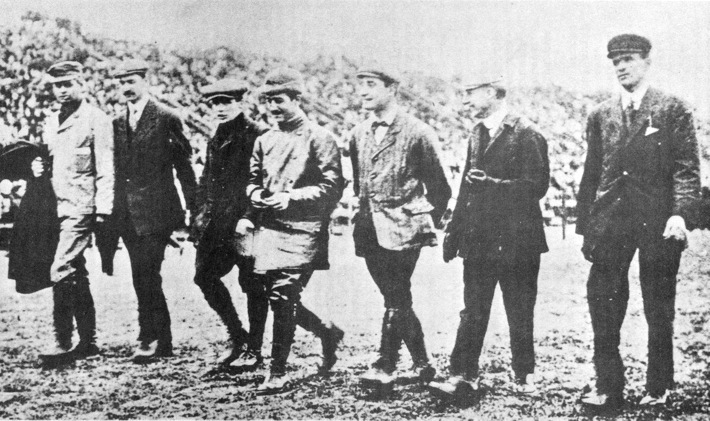
 Back to the top of
the page
Back to the top of
the page